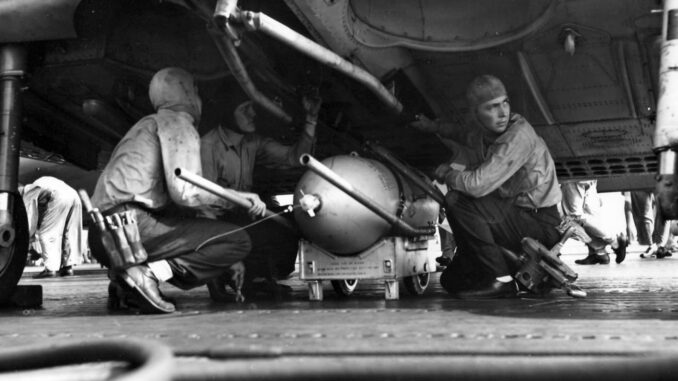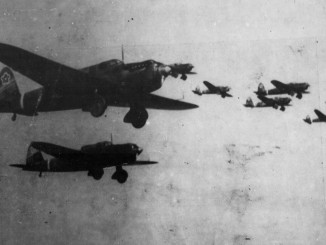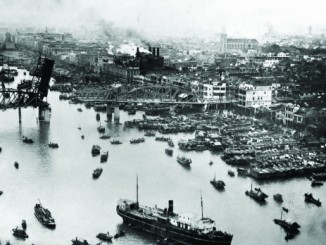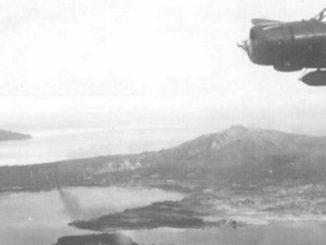
As the largest invasion fleet assembled so far in the war approached Guadalcanal to begin the landing operations, the first order of business for VAdm Frank J. Fletcher’s Task Force 61 was to clear the immediate area of air opposition, and then to assist with the softening up of the beaches. At 0530 the first wave of 93 aircraft took off to attack the landing areas, including no less than 44 fighters for strafing and air cover. Taking off in the pre-dawn darkness many of the pilots got lost and failed to join up with their formations, so it was a rather disjointed force that made its way to Guadalcanal and Tulagi.
Fighters from Wasp’s VF-71, eleven in all, swept in low towards the seaplane base at Tulagi. A unit of H6K flying boats from the Yokohama Kokutai was caught on the water preparing to take off for dawn searches, and a unit of A6M2-N floatplane Zeros was also unprepared. All the aircraft were quickly flamed by the Americans, seven H6Ks and six Zeros in all. Several supporting boats and shore installations were also burned, removing any chance that the Tulagi unit could interfere with the landings. SBDs from Wasp followed up these attacks by dropping bombs on various shore installations, all without encountering any serious anti-aircraft fire.
At Guadalcanal the Saratoga Air Group took the lead. The Lunga Point airfield was approaching completion, but 12 VF-5 fighters strafed every likely target, including the “pagoda” and several hangars. There was no return fire from anti-aircraft guns, even though several guns were in position around the airfield. There were even two Type 11 radar sets, but these were apparently not operating that morning having failed to provide any warning. 26 SBDs followed up the strafing attack by bombing structures around the airfield. The attack caused Japanese troops and construction crews around the field to flee for the hills, and the airfield was captured without incident two days after the marines came ashore. All bombing missions were halted after midday as the operation was proceeding well – the Guadalcanal landings were unopposed, and the marines on Tulagi had the situation well in hand despite heavy fighting.
Afternoon Air Attacks
At Vunakanau airfield near Rabaul, the 4th Kokutai was preparing for a mission of its own when news of the American landings arrived. The 4th was slated to attack a newly discovered Allied airfield at Rabi, on the eastern tip of New Guinea and 27 G4Ms were bombed up and ready to depart when the new threat became evident. RAdm Sadayoshi Yamada, commander of the 5th Base Air Force, elected to send these bombers to Guadalcanal instead, judging that the new landings were a more significant threat. Keen to strike early, Yamada ordered the 4th to attack with bombs instead of re-arming them with potentially more deadly torpedoes. The Tainan Kokutai was to supply 18 Zeros as escort, even though Guadalcanal was at the extreme limit of the Zero’s range – well over 500 miles from Rabaul. At about 10am, just 90 minutes after news of the American invasion had arrived, the 4th and Tainan Kokutai were on their way to Guadalcanal.
Even though no land-based radar was yet operational at Lunga, the Allied intelligence network provided early warning of the incoming strike. Coastwatcher Paul Mason, stationed near Buin in southern Bougainville, radioed “24 bombers headed yours” to Turner and Fletcher at around midday when he spotted the 4th Ku bombers at high altitude. The message arrived in plenty of time but there were nevertheless difficulties in preparing a defensive effort.
News of the incoming Japanese air attack was no real surprise, but the tactical situation meant that the Americans had to plan the defence carefully. Fletcher’s fighters had to defend two locations, about 60 miles apart – his own carriers and Turner’s landing force. Wildcats had to be kept on station to protect both locations, which were not mutually supporting. This placed an enormous burden on the three fighter squadrons and the Fighter Direction Officers responsible for their deployment. As the FDOs struggled to make sense of the likely attack direction, fighters were dispatched as either “CV CAP” for the carriers or “Screen CAP” (SCAP) for Lunga, with the carriers taking priority. Matters were not helped by the F4F’s short endurance, which meant that the CAPs had to be replaced regularly with fresh, fully fuelled fighters. Consequently, when the Japanese finally arrived over Guadalcanal there were just 8 SCAP F4Fs from Saratoga’s VF-5 on station.
Four of the Wildcats were led by Lt James Southerland. The FDO aboard the cruiser Chicago vectored his flight towards the incoming Japanese who were at the time inside a large cloud bank and out of sight. When the G4Ms burst out of the cloud bank Southerland’s fighters were just a few hundred yards away and he immediately led them into the attack, but the escorting Zeroes were equally alert and two F4Fs were shot down immediately, leaving Southerland to attack alone. He shot down one of the bombers and damaged another, before return fire damaged his fighter requiring him to break off. The second flight of Wildcats also made attacks on the bombers but without apparent success.
The remaining bombers arrived over Turner’s fleet and commenced bombing. Their aim was poor, and the bombs landed between transports and cruisers, but hit nothing – nevertheless the bombardiers claimed a destroyer sunk and transport damaged. Immediately afterwards the American fighters returned and damaged more of the G4Ms forcing a response from the escorts which resulted in two more F4Fs being shot down. The remaining Wildcats, some of them damaged, turned for home. Southerland was ambushed by more Zeros, culminating in a famous dogfight with the renowned Japanese ace PO1c Saburo Sakai who poured fire into Wildcat. Southerland was finally forced to bail out of his battered fighter and make his way towards the American lines. In all 5 of the 8 VF-5 Wildcats were shot down.
Sakai meanwhile followed up by attacking a nearby formation of SBDs. Making a poorly executed stern attack, Sakai was severely injured by the defensive guns of the dive-bombers – a bullet hit his skull and blinded him on one eye. Despite this severe wound, Sakai was able to maintain control of his Zero and set course for home. Battling blood loss and partial blindness, Sakai managed to fly the 550 miles home to Rabaul and land safely. He was evacuated back to Japan to recuperate but would fly again despite the loss of his eye.
Whilst the VF-5 Wildcats were fighting for their lives, 10 more F4Fs from VF-6 and eight from VF-71 attempted to intervene. Four VF-6 fighters under Lt Vincent de Poix were first to arrive as the bombers were beginning their withdrawal towards Santa Isabel Island. They made one firing pass on the formation of G4Ms before the escort was able to react, but soon the Zeros shot down one of the F4Fs and forced the others to scatter. The remaining six VF-6 fighters under Lt(jg) Gordon Firebaugh caught up with the bombers almost at the extreme range of their F4Fs. The Tainan fighters, now about 16 in number, again put up an excellent defence of the bombers, quickly shooting one Wildcat down. Firebaugh claimed two of the Zeroes whilst his charges finished off two more bombers, but Firebaugh was himself forced to bail out of his badly damaged fighter. The VF-71 fighters did not arrive in time to fight the Japanese.
In the defence of the invasion fleet half of the American fighters that were engaged were lost, 9 Wildcats in total. They managed to shoot down four bombers and two Zeroes, with two more G4Ms written off due to battle damage.
The Japanese launched one more attack on the 7th by nine D3A dive bombers. These aircraft lacked the fuel to fly from Rabaul to Guadalcanal and return, so it was planned that they would ditch near Shortland harbour on the return leg. These dive bombers only carried small 60kg bombs so it was doubtful they could do much damage to enemy warships. They arrived near Lunga almost an hour after the G4Ms left and attacked without escort. They scored a hit on the destroyer Mugford that killed 21 men. Five of the D3As were shot down by fighters and American AA fire, and the remaining four ditched at Shortland as planned.
To cap off a busy day of air operations, the US Fifth Air Force got into the action when it launched a raid by heavy bombers on Vunakanau airfield. 13 B-17s from the 19th Bomb Group took off from Port Moresby as the 4th Kokutai was busy attacking Guadalcanal, and they reported bombing the airfield despite strong fighter opposition from the 2nd Kokutai’s Zero 32s which caused the loss of one Fortress. No Japanese aircraft were destroyed on the ground by Gen George C. Kenney, commander of the Fifth, claimed based on faulty intelligence that his bombers had destroyed 75 planes “parked wingtip to wingtip” at Vunakunau.
Photo Album
D Plus One
The following day RAdm Yamada was determined to find the enemy carriers and attack them. Five reconnaissance aircraft were launched followed an hour later by 26 torpedo-armed bombers from the 4th and Misawa Kokutai and 15 Zeros. When the search planes failed to report any American carriers in the vicinity, the strike group set course for Tulagi and the transport fleet. Due to communications foul-ups and fuel worries, there were only three F4Fs on station over Savo Sound although 14 more were hurrying north to join them. Task Force 62 would have to rely primarily on its own anti-aircraft guns to repel the attack.
The Japanese bombers had flown at low altitude north of the Solomons to shield themselves from American radar. As a result, they were first sighted visually just before midday by lookouts. AA guns quickly swung into action and opened up as the G4Ms descended to low level to begin their torpedo attack, whilst TF62 turned away. Almost immediately bombers began to crash in flames as the American gunners found their targets, some of the wrecks barely missing ships as they splashed. One G4M smashed into the transport George F. Elliot and started a large fire. She was later beached and, beyond saving, was allowed to burn out. Very few torpedoes appear to have been launched and the only ship that was hit by a ‘fish’ was the destroyer Jarvis. She was struck forward near her bow and immediately started to take on water.
The three F4Fs on patrol responded to radio calls for help and dived from high altitude down to the deck. There they came across several bombers making their escape at low level, and quickly shot down four of them as well as one of the escorting Zeros, which was itself distracted by a cruiser based SOC in the area.
The attack was disastrous for the 4th and Misawa Kokutai. Seventeen Type 1 bombers were destroyed in the attack, and another crashed after having aborted early. In return they had managed to damage a transport and a destroyer but had otherwise nothing to show for their efforts despite hysterical claims of dozens of cruisers and transports sunk or damaged. It was the worst single day loss of Japanese bombers during the entire Guadalcanal campaign and highlighted the extreme vulnerability of the G4M to American firepower.
Following the successful defence of TF62, Fletcher reviewed his aircraft situation. During two days of operations his carriers had lost 21 fighters to enemy action and operational accidents, more than 20% of his total strength. Aware that Rabaul-based aircraft posed a serious threat to his carriers and that Japanese submarines were likely hunting for TF61, Fletcher determined that it was too dangerous to remain in the area and requested permission from Ghormley to withdraw early. At the time of making his request he believed that TF62 would shortly make its own withdrawal, but the Japanese attacks had disrupted unloading operations and Turner had elected to keep his ships in the area longer to give the marines more time to unload their supplies and equipment. Overnight Fletcher had TF61 sail southeast, away from Guadalcanal, but still within range to support Turner should the need arise. The Japanese had other plans. Their 8th Fleet, a powerful force of heavy cruisers under the command of VAdm Gunichi Mikawa, was rapidly concentrated at Rabaul and made ready to sail for Guadalcanal. The stage was set for the US Navy’s worst ever disaster.








Leave a Reply